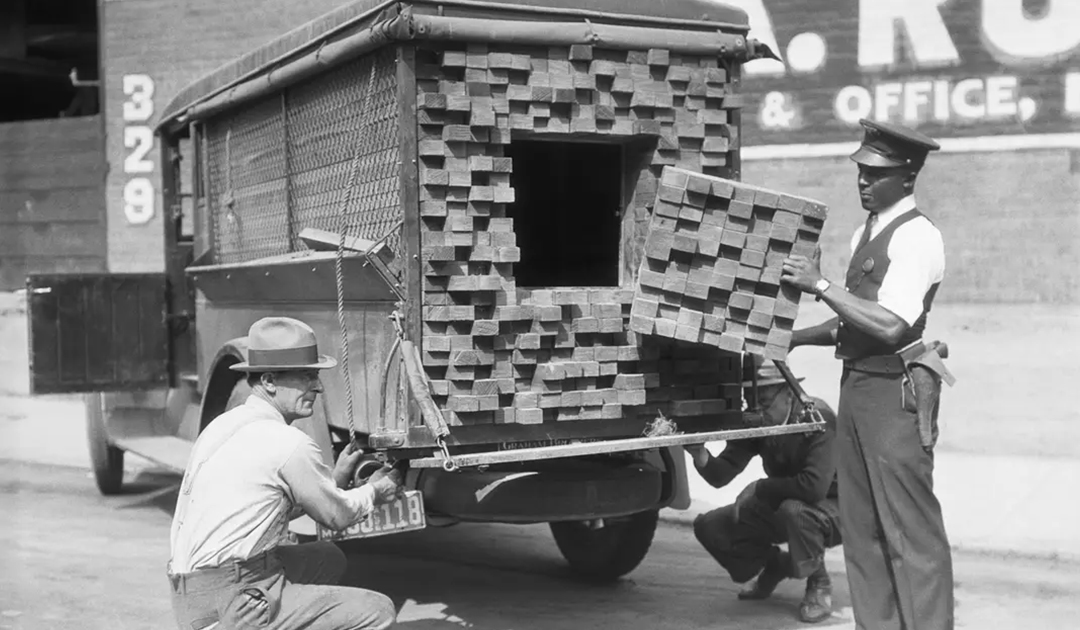On January 16 1919, the 18th Amendment went into effect one year later, by which time no fewer than 33 states had already enacted their own prohibition legislation. In October 1919, Congress put forth the National Prohibition Act, which provided guidelines for the federal enforcement of Prohibition. Championed by Representative Andrew Volstead of Minnesota, the chairman of the House Judiciary Committee, so the legislation was more commonly known as the Volstead Act.
No law, however, could suddenly transform the United States into a country of teetotalers.
Enterprising moonshiners produced millions of gallons of illegal hooch, organized crime flourished as it moved into bootlegging operations and tens of thousands of speakeasies popped up across the country.
Moonshiners working outdoors in rural areas of the country devised a clever method to cover their tracks-literally. In order to evade Prohibition agents, moonshiners attached to their shoes wooden blocks carved to resemble cow hooves. That way, any footprint left behind would appear to be bovine, not human, and not attract suspicion. Aside that, Americans who continued to consume alcohol had to find creative ways to hide their booze, such as conceal liquor flasks into faux books.
Let us though, shed some light a few things that you probably didn’t know about the Prohibition era.

Prohibition had been tried before.
In the early 19th century, religious revivalists and early teetotaler groups like the American Temperance Society campaigned relentlessly against what they viewed as a nationwide scourge of drunkenness. Calls for a “dry” America continued into the 1910s when deep-pocketed and politically connected groups such as the Anti-Saloon League and the Women’s Christian Temperance Union.
It wasn’t illegal to drink alcohol during Prohibition.
The 18th Amendment only forbade the “manufacture, sale and transportation of intoxicating liquors”—not their consumption. By law, any wine, beer or spirits Americans had stashed away in January 1920 were theirs to keep and enjoy in the privacy of their homes. For most, this amounted to only a few bottles, but some affluent drinkers built cavernous wine cellars and even bought out whole liquor store inventories to ensure they had healthy stockpiles of legal hooch.

Some states refused to enforce Prohibition.
Maryland never even enacted an enforcement code, and eventually earned a reputation as one of the most stubbornly anti-Prohibition states in the Union. New York followed suit and repealed its measures in 1923, and other states grew increasingly lackadaisical as the decade wore on.
Drug stores continued selling alcohol as “medicine.”
The Volstead Act included a few interesting exceptions to the ban on distributing alcohol. Sacramental wine was still permitted for religious purposes and drug stores were allowed to sell “medicinal whiskey” to treat everything from toothaches to the flu. With a physician’s prescription, “patients” could legally buy a pint of hard liquor every ten days. This pharmaceutical booze often came with seemingly laughable doctor’s orders such as “Take three ounces every hour for stimulant until stimulated.”
Winemakers and brewers found creative ways to stay afloat.
While many small distilleries and breweries continued to operate in secret during Prohibition, the rest had to either shut their doors or find new uses for their factories. Yuengling and Anheuser Busch both refitted their breweries to make ice cream, while Coors doubled down on the production of pottery and ceramics. Others produced “near beer”—a legal brew that contained less than 0.5 percent alcohol. The lion’s share of brewers kept the lights on by peddling malt syrup, a legally dubious extract that could be easily made into beer by adding water and yeast and allowing time for fermentation. Winemakers followed a similar route by selling chunks of grape concentrate called “wine bricks.”
There were also many unintended consequences of Prohibition. Some cash-strapped restaurants shuttered their doors since they could no longer make a profit from liquor sales. Thousands of people died each year from drinking cheap moonshine tainted with toxins. And revenues shrank for many states that had previously relied on liquor taxes to fund roads, schools and other public benefits.
FDR’s victory meant the end of Prohibition, and in February 1933 Congress adopted a resolution proposing a 21st Amendment to the Constitution that would repeal the 18th.
Even after the repeal of Prohibition, some states maintained a ban on alcohol within their own borders. Kansas and Oklahoma remained dry until 1948 and 1959, respectively, and Mississippi remained alcohol-free until 1966—a full 33 years after the passage of the 21st Amendment. To this day, 10 states still contain counties where alcohol sales are prohibited outright.

